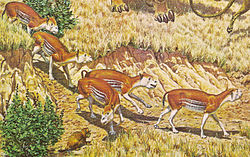- Merychyus
-
Merychyus
Temporal range: 35–5 Ma Late Eocene to Miocene[1]
Restoration of a herd of Merychyus Scientific classification Kingdom: Animalia Phylum: Chordata Class: Mammalia Order: Artiodactyla Suborder: Tylopoda Family: †Merycoidodontidae Genus: Merychyus Merychyus is an extinct genus of terrestrial herbivore of the family Merycoidodontidae (oreodont), endemic to North America during the Oligocene-Pliocene subepochs (24.8—4.9 mya) existing for approximately 19.9 million years.[2]
Merychyus was a cud-chewing plant-eater with a short face, tusk-like canine teeth, heavy body, long tail, short feet, and four-toed hooves.
Contents
Taxonomy
Merychyus was named and assigned to Merycoidodontidae by Joseph Leidy (1858) and Lander (1998); and to Merychyinae by Parris and Grandstaff (2003).[3]
Morphology
Four specimens were examined by M. Mendoza for body mass and estimated to have a weight of:
- Specimen 1: 98.4 kg (216.9 lbs).
- Specimen 2: 81.5 kg (179.6 lbs).
- Specimen 3: 83.1 kg (183.2 lbs).
- Specimen 4: 112.3 kg (247..5 lbs).[4]
Fossil distribution
Fossils are widespread through the central and western United States.
Species
M. arenarum (syn. M. delicatus, M. euryops), M. crabilli, M. elegans (syn. M. jahnsi) (type species), M. major (syn. Merycochoerus californicus), M. medius, M. minimus (syn. M. calaminthus, M. paniensis, M. verrucomalus), M. novomexicanus (syn. Ustatochoerus skinneri), M. relictus, M. smithi (syn. M. calimontanus, Ticholeptus tooheyi), Ustatochoerus leptoscelos
Resources
- ^ Palmer, D., ed (1999). The Marshall Illustrated Encyclopedia of Dinosaurs and Prehistoric Animals. London: Marshall Editions. p. 270. ISBN 1-84028-152-9.
- ^ PaleoBiology Database: Merychyus, basic info
- ^ B. Lander. 1998. Oreodontoidea. In C. M. Janis, K. M. Scott, and L. L. Jacobs (eds.), Evolution of Tertiary mammals of North America 402-425
- ^ M. Mendoza, C. M. Janis, and P. Palmqvist. 2006. Estimating the body mass of extinct ungulates: a study on the use of multiple regression. Journal of Zoology
Categories:- Oreodonts
- Oligocene mammals
- Pliocene extinctions
- Prehistoric mammals of North America
Wikimedia Foundation. 2010.
